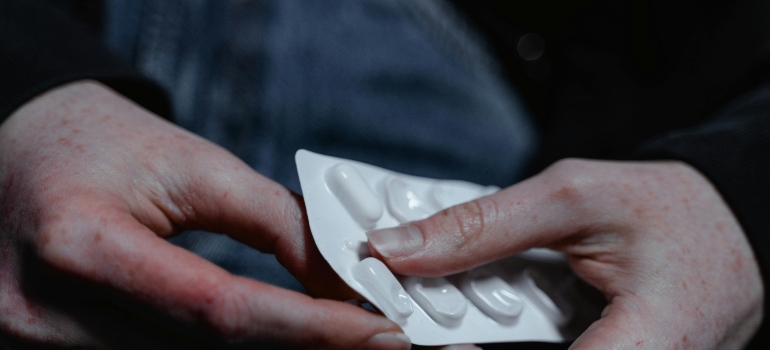Xanax is a medication commonly prescribed to treat anxiety and panic disorders. It works by calming the nervous system and helping people manage overwhelming feelings of stress or fear. Many individuals rely on it to regain control over their mental health, especially during challenging situations. However, its use goes beyond medical purposes, as some people take it recreationally or to cope with everyday pressures. This raises an important question: why do people take Xanax? Understanding the reasons behind its use – both medically and non-medically – can help shed light on its benefits and risks, which we’ll explore in this article. If you or someone you know is struggling with Xanax use, seeking help from a trusted treatment center like Harmony Ridge Recovery Center WV can be an essential step toward recovery.

Medical Uses of Xanax
Xanax is a prescription medication used to treat anxiety and panic disorders. Doctors prescribe it to help people manage overwhelming feelings of stress or fear. It belongs to a class of drugs called benzodiazepines, which work by calming the brain and nervous system. Many people rely on Xanax for short-term relief from symptoms like restlessness, excessive worrying, or rapid heart rate. It is especially helpful during anxiety attacks or when facing stressful events like public speaking or exams. Doctors often recommend it for short-term use because extended use can lead to dependence. The effects of Xanax are usually felt quickly, making it effective for immediate relief.
However, medical professionals monitor its use carefully to prevent misuse or overreliance. Understanding its proper purpose is important, especially when asking, “Why do people take Xanax?” While it can improve the quality of life for those with anxiety disorders, it should only be used under medical supervision. This approach helps avoid unnecessary risks while addressing mental health challenges effectively.
Non-Medical Use: A Growing Concern
Non-medical use of Xanax has become a growing concern in recent years. Many people take it without a prescription, often under the false belief that it is safe. Some misuse it to escape stress, manage emotional pain, or simply relax. Others may take it recreationally to feel a sense of calm or euphoria. This trend is alarming, as misuse can lead to serious risks like dependence, memory problems, and even overdose. Studies show that young adults are particularly prone to misusing Xanax, often influenced by peer pressure or easy access. Social media and online platforms also contribute, making it easier to obtain the drug illegally. This raises questions like, why do people take Xanax outside of medical supervision? Misuse often stems from a lack of awareness about its dangers. People may not realize that using it without medical guidance can have long-term consequences.
Misusing Xanax for temporary relief often creates bigger problems over time. Addressing this issue involves educating others about the risks and encouraging healthier ways to cope with stress or anxiety. Recognizing the signs of misuse early can help prevent serious outcomes and promote safer choices.

Why Do People Take Xanax at Parties
Xanax use at parties has become increasingly common, especially among young adults. Some people see it as a way to enhance their social experience, but this practice comes with serious risks. Let’s look at why Xanax is often used in social settings and the dangers it presents.
To Feel Relaxed and Confident
At parties, Xanax is sometimes taken to feel more relaxed and less anxious. Social situations can make people feel nervous or out of place, and they may use Xanax to calm down. This can create a false sense of confidence, making it easier to engage with others.
Peer Influence and Group Dynamics
Peer pressure plays a significant role in Xanax use at parties. If a group is using the drug, others may feel the need to join in to fit in or feel included. This group dynamic makes it easier for people to overlook the potential dangers of taking Xanax without medical supervision.
Combining Xanax with Alcohol
One of the most dangerous practices at parties is combining Xanax with alcohol. Many people mix the two to amplify their effects, but this combination is risky. It can lead to extreme sedation, loss of coordination, and even life-threatening overdoses.
Taking Xanax at parties might seem harmless to some, but the risks outweigh the benefits. People should understand the dangers of misusing the drug, especially in social settings, and choose safer alternatives for managing stress and social anxiety.
The Risks and Long-Term Effects of Xanax Misuse
Recognizing Xanax addiction can be challenging, but there are several clear signs to look for. One of the most common indicators is increased usage. If someone starts taking Xanax more frequently or in higher doses than prescribed, this may signal a growing dependence. They might also begin to rely on the drug to handle everyday stress or anxiety. Another warning sign is when a person experiences cravings or feels the need to take Xanax even if they don’t have a prescription.
People struggling with addiction often show changes in behavior. For example, they may become secretive about their drug use or try to hide how much they’re taking. They might also start neglecting responsibilities at work or in relationships due to their focus on obtaining or using Xanax. Social isolation is also a common pattern, as the individual may prefer to be alone or with people who are using the drug as well.
Physical signs can also point to addiction. These may include slurred speech, poor coordination, or drowsiness. If someone experiences withdrawal symptoms, such as anxiety, irritability, or shaking, when they stop taking Xanax, it’s another sign that addiction may be present. Over time, addiction can cause significant damage to both mental and physical health.
If you notice these behaviors in someone close to you, it’s important to approach them with care. Recognizing Xanax addiction early can help prevent further harm and encourage the person to seek benzo addiction treatment. These programs help individuals gradually reduce their use of benzodiazepines like Xanax, using a medically supervised approach to minimize withdrawal symptoms. Professional treatment can provide support and help individuals rebuild their lives.

How to Recognize Xanax Addiction
Recognizing Xanax addiction is important for getting the right help. People who misuse Xanax often show clear signs that something is wrong. These signs may not always be obvious at first, but over time, they become harder to ignore. Let’s explore some of the common signs that someone might be struggling with a Xanax addiction.
- Increased Dependence on the Drug: A key sign of addiction is the growing need for Xanax. Someone may start taking more than their prescribed dose or use it more often than directed. Over time, they might find it harder to get the same effects with smaller doses and may increase their intake to feel the same way.
- Withdrawal Symptoms: When someone tries to stop taking Xanax, they may experience withdrawal symptoms. These can include anxiety, irritability, trouble sleeping, and even physical symptoms like sweating or shaking. Withdrawal symptoms can make it difficult for someone to quit, even if they want to.
- Behavioral Changes: People with a Xanax addiction may also show behavioral changes. They may become secretive or lie about their drug use. You might notice they spend a lot of time thinking about or seeking Xanax. Social interactions or hobbies may become less important to them as the addiction takes over.
- Problems at Work or in Relationships: Xanax addiction can cause problems at work or in personal relationships. Someone might start missing work, performing poorly, or isolating themselves from friends and family.
Recognizing Xanax addiction early can help someone get the support they need before the situation gets worse. If you notice any of these signs in yourself or someone you care about, seeking professional help can make a big difference.

Treatment Options for Xanax Addiction
Overcoming Xanax addiction can be difficult, but it is possible with the right treatment. Several treatment options are available to help people recover and rebuild their lives. Let’s look at some of the most common methods used to treat Xanax addiction. A partial hospitalization program in West Virginia offers structured support for those needing intensive care while maintaining some independence.
Detoxification
The first step in treating Xanax addiction is detox. During detox, the body clears out the drug. This process can be uncomfortable and may involve withdrawal symptoms. Detox should be done under medical supervision, as withdrawal from Xanax can be dangerous. Medical professionals can help manage symptoms and keep the person safe during this stage.
Inpatient Rehabilitation
Inpatient rehab is a more intensive form of treatment. Patients live at a treatment facility for a certain period, receiving around-the-clock care. This type of treatment offers structured therapy and support in a controlled environment, allowing people to focus on their recovery without outside distractions.
Outpatient Rehabilitation
Outpatient rehab is a less intensive option. People attend therapy sessions during the day but return home at night. This can work for individuals who have already completed detox or inpatient rehab and need continued support. Outpatient care provides flexibility, allowing people to continue with work or school while focusing on recovery.
Counseling and Therapy
Therapy plays a key role in recovering from Xanax addiction. Cognitive-behavioral therapy (CBT) is often used to help people understand their addiction and develop healthier ways to cope with stress and anxiety. CBT treatment plans for substance abuse focus on identifying negative thought patterns and replacing them with positive, healthier behaviors. Therapy can also help address any underlying issues that may have contributed to the addiction, such as trauma or mental health disorders.
Support Groups
Support groups like Narcotics Anonymous (NA) or SMART Recovery offer a space for people to connect with others who are going through similar experiences. These groups provide ongoing support and encouragement, which can be vital during the recovery process.

Safer Alternatives and Approaches to Anxiety Management
Managing anxiety without relying on prescription medication, like Xanax, is possible with safer alternatives. There are many approaches that help reduce anxiety naturally. These methods focus on long-term solutions, rather than quick fixes, and can be used alongside therapy or medical treatment.
One effective option is mindfulness meditation. It teaches you to focus on the present moment and breathe deeply. Research shows that mindfulness can lower stress and anxiety levels. Simple breathing exercises, such as deep belly breathing, also help activate the body’s relaxation response.
Another helpful method is regular exercise. Physical activity releases endorphins, which are chemicals in the brain that improve mood. Even walking for 30 minutes a day can make a difference in anxiety levels. Exercise also helps improve sleep, which is often affected by anxiety. Certain herbs, like lavender and chamomile, have calming properties. Drinking herbal teas or using essential oils may help reduce feelings of anxiety. However, always check with a healthcare provider before using these, as they may interact with other medications.
Finally, lifestyle changes can also reduce anxiety. Prioritizing sleep, maintaining a healthy diet, and staying connected with loved ones can all contribute to mental well-being. Motivational interviewing for substance abuse is another supportive approach, as it helps individuals find the motivation to change harmful behaviors and adopt healthier coping strategies for anxiety.

So, Why Do People Take Xanax?
Understanding why people take Xanax is important for recognizing both the benefits and risks associated with this medication. Xanax is often prescribed to treat anxiety and panic disorders, helping many individuals manage their symptoms effectively. However, it’s clear that some people misuse it for recreational purposes, which can lead to dangerous consequences. Recognizing signs of addiction early and seeking help can make a significant difference in recovery. Fortunately, there are safer alternatives and approaches to anxiety management, such as mindfulness, exercise, therapy, and lifestyle changes. These options provide people with the opportunity to manage their anxiety without relying on medication. If you or someone you know is struggling with Xanax use, it’s important to reach out for professional support. Exploring drug rehab centers in WV can be a great first step toward healing and regaining control of your mental health.



